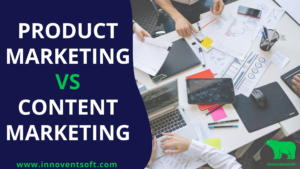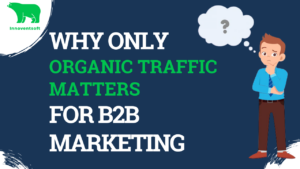B2B buying is changing
Selling B2B products or services has become more challenging as buyers develop perceptions about brands and make purchasing decisions quickly. B2B organizations can’t rely on their direct sales alone; they need to strengthen their digital marketing strategies to win customers, as most of the product or service users are millennials who spend over 13 hours daily on digital channels.
B2B companies must adapt to changing consumer dynamics and prepare content relevant to customers at various lifecycle stages of the buying process. They should realize the anti-pattern of generating leads through ineffective ads. In this blog, we’ll look at a B2B customer’s life-cycle journey through Innoventsoft’s upgraded AIDA++ model. We’ll closely look at each stage of a buyer’s journey and recommend changes you can apply in content strategy to win the audience.
Understanding B2B customer life cycle journey for content strategy
For many B2B firms, AIDA serves as a default sales/marketing model. The AIDA model stands for awareness, interest, desire, and action model, which are the four stages of a customer’s life cycle journey while making a purchase. Matured B2B organizations carry out their sales and marketing activities to move their prospects from the awareness stage to the action stage where they make the purchase.
At Innoventsoft, we promote an upgraded model of AIDA for the B2B sales and marketing department, called the AIDA++ model. It’s based on the AIDA framework and Gartner’s B2B buying process for technology products or services. Many B2B CMOs have won their customers through inbound and outbound sales using our model.
(Please note, although the words’ prospect’ and ‘customer’ signify a lead before and after purchasing a solution, respectively, we shall be using them interchangeably.)
Using the AIDA++ framework for creating a content strategy
AIDA++ is an extension of the AIDA model with granular stages. It includes stages: Awareness, Interest to research, Interest to compare, Desire to purchase, Act and use, Experience, Loyalty, and Word of mouth. Let’s look at each stage and see the strategy you can use, content types you need to produce, and B2B marketers you need to collaborate with, to win the audience effectively.

Please read the below brief description of each stage in our AIDA++ Model and respective content strategy to win the audience.
1. Awareness
At this stage, the prospect is aware of their problems. If they are unaware, there must be an adequate mechanism in the content strategy to make them aware of their pain points and the potential rewards if they overcome them.
For instance, let’s assume that you offer a SaaS-based platform to enterprises that automate SEO analysis and help digital marketers optimize their web content. (We’ll keep referring to this example.) At the awareness stage, instead of coming up with topics around various tools for SEO analysis, focus on educating the prospects about what SEO is. You can create content such as What is SEO, What is website content optimization, New trends in online marketing and SEO, etc. This way, you can prepare the prospects and lead them to the next stage.
a.Content Strategy: Educate about the market.
b.Content Types:
- White paper on topics related to new trends
- Controversial blogs on why the status quo sucks
- Webinars and podcasts on the emerging trends the buyer should know.
- Educate about new terminologies, glossary, educational and training videos regarding the new market, and more.
c. Team B2B marketers need to collaborate with: Leaders such as CXOs and VPs of the organization.
2. Interest for Research
A problem-aware customer will instantly try to find a solution offered by different vendors at this stage. A desire to solve their problem will lead to thorough research, and using a fresh approach or process, or free (open source) products.
Following the previous example, at this stage, the prospects want to know more. You can show them how to perform SEO or content optimization and produce content outlining the benefits of SEO analysis. By doing things themselves or by subscribing to a free trial of your platform, you will instantly increase your prospects’ interest in your product.
a. Content Strategy: Provide freebies.
b. Content Types:
- Technique documents such as e-books or planning guides outlining tips and tricks to solve their problems
- Free trial of the product
- Free services to gauge or track their maturity in solving a problem.
c. Team B2B marketers need to collaborate with: Product managers, Engineering heads, Product heads, and Sales heads.
3. Interest for Comparison
Once a customer understands that a solution is necessary for their organization to scale and grow, they are likely to interact with the vendor. At this stage, they would like to evaluate various solutions and pick the top 2-3 vendors for evaluation. They are more likely to search online, visit the vendor’s website, and explore their solution and case studies. Also, by following the vendor’s social media, they get notifications about improvements regarding products or solutions the vendor offers. They are also open to engaging with the vendor’s sales personnel.
Coming back to the example, you’ve adequately educated your audience about SEO and given them tips and tricks to perform SEO themselves. A free trial of your product has motivated them to buy, but they don’t buy just yet. At this stage, your prospect will look for alternatives, and you need to produce content comparing your product with other tools available for SEO analysis in the market. Also, explain why your platform is better than your competitors’ and convince your audience to go for your product by providing case studies.
a. Content Strategy: Convince.
b. Content Types:
- Competition blogs specifying why you are better
- Comparison charts between other technologies or status quo processes
- Datasheets, product or service differentiator documents such as a blog or an e-book, and videos explaining your unique selling proposition (USP)
- A couple of concise case studies.
c. Team B2B marketers need to collaborate with: Product managers, solution owners, vertical heads, and head of delivery.
4. Desire to Purchase
At this stage, customers move closer to the purchase. They usually start discussions on how a vendor’s solution can provide them value and might request a minor engagement such as proof-of-concept (POC), or proof-of-value (POV). The customer might consider the solution in the long run.
Since you’ve made your prospects aware of your SEO analysis tool’s USP and other benefits, you can focus on content that will further engage them in the product. Topics around benefits such as faster ROI (Return on Investment), and how easily they can integrate the platform with their ecosystem, will engage your audience.
a. Content Strategy: Engage.
b. Content Types:
- First-call deck, elevator pitch, pricing sheet, case studies, and battle cards
- Product demo, integration documents, and installation and implementation documents
- How to guides and product or solution docs for users.
c. Team B2B marketers need to collaborate with: the sales head, product head, solution head, and delivery head.
5. Act and Use
Once customers understand the product features and value proposition, they would ideally move to the purchase stage. The sales team plays a crucial role here as they will have to chase the customer, negotiate, and close the deal. Although B2B marketers have a minor role, this stage is vital to understanding customer sentiments. Based on the win/lose analysis coupled with customer feedback, B2B marketers can understand hidden pain points of customers to try or not-try your product or services.
a. Content Strategy: Observe attentively.
b. Content Types: Although marketers can’t prepare content for this stage, they can:
- Record sales call with customers/prospects.
- Ensure that sales folks and SDRs (Sales Development Representatives) provide adequate feedback after each customer call.
c. Team B2B marketers need to collaborate with: Sales, Sales Engineers, and pre-sales.
6. Experience
At the experience stage, the users in the customer organization use the product or service and try to get the value as per the brand promise. Usually, the value delivery happens in phases. The most involved folks are the customer (client) success or delivery partners, responsible for overseeing the installation, implementation, and other professional services related to the solution.
a. Content Strategy: Listen and note.
b. Content Types:
- Case studies
- Case stories
- Customer quotation
c. Team B2B marketers need to collaborate with: Product Support, Customer/Client Success, Account Managers, and Product Managers.
7. Loyalty
This is the phase when a customer sees value from the solution implementation in their environment. If they are happy, they become repeat customers, and that’s how vendors would earn their recurring revenue. They are likely to opt out of the subscription or service and switch vendors if unsatisfied. Hence, it’s ideal to find and analyze the sentiments and loyalty of existing customers. Analysis like churn rate and NPS (Net Promoter Score) can be helpful for companies at this stage.
a. Content Strategy: Consider if only there is a churn.
b. Content Types:
- NPS score
c. Team B2B marketers need to collaborate with: Product Support, Customer/Client Success, and Account Managers.
8. Word of Mouth
At this stage, customers are usually happy with the solution and recommend the brand to their peers. Similarly, if unsatisfied, they would stop using or referring to the solution. They may provide reviews in various forums like Gartner peer reviews, G2Crowd, and more.
a. Content Strategy: Fetch reviews.
b. Content Types:
- Online reviews
- Quotes
c. Team B2B marketers need to collaborate with: Customer/Client Success, Account Managers.
Content Execution and Collabration:
B2B marketers have to prepare content by taking the customer journey into account. Once the content is ready, next comes the outreach. It’s essential to produce content in various forms — such as blogs, videos, and audio — and publish them in different digital media, including your website. These mediums have made brands more visible and transparent to the customers and have disrupted the traditional funnel approach used in B2B sales and marketing. Since customers can refer to the content at any stage, B2B brands have to make an impact by selling at each step of the customer lifecycle journey.
B2B marketers have to collaborate with other team members such as CXOs, sales, product managers, client success, professional service and support, engineers, and the likes, which makes efficient coordination a must. Remember, every company is a software company in the 21st century. Likewise, every rep in a company is a marketer.
Despite considerable technological advancements in the last decade, most sales and marketing models still comprise a traditional approach to the market with reactive decision-making. If B2B organizations consider the orthodox stream of reaching customers – by depending solely on sales or taking part in events to generate leads – it will prove inadequate in the long run. Instead, create content for customers at various stages of the funnel, and provide them with the best user experience possible. It will keep your audience hooked and help them convert to customers.
How is Innoventsoft making a Difference?
It’s high time B2B organizations realize that buying is now continuous and online, and it’s a regular movement of customers from the awareness stage to the word-of-mouth stage. Innoventsoft helps US-based startups and large firms reconfigure their go-to marketing processes and make them more effective. We offer an Intelligent Content Marketing (ICM) platform to aid marketers in better coordinating with their team to prepare content for customers in their different stages of the buying process.






